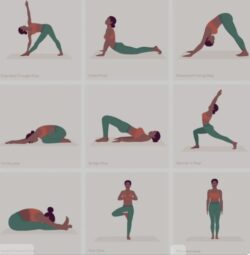Yoga originated in India over 5,000 years ago and is increasingly growing in popularity year after year. Beyond its reputation as a form of physical exercise it is also very good for mental and physical health.
In this article, I am going to explain the benefits of yoga for mental and physical health. But, before I explain the benefits of yoga for mental and physical health, I am going to discuss the key components to yoga, to give you a better understanding.
As an added bonus, I am going to go through some best yoga exercises for beginners, as well as giving you some advanced exercises for when you master the beginner exercises.
Understanding Yoga: The Key to Getting Started
Yoga is mainly associated with posing on a mat, but it’s essence goes far beyond physical yoga poses. At it’s core, the aim of yoga to create a balance within the mind, body, and spirit.
Some of the key components to yoga are:
1. Asana (Physical Postures): Asanas, or yoga postures, are what most people think of when they think of yoga. These postures are designed to improve flexibility, strength, and balance.
2. Pranayama (Breath Control): Pranayama focuses on control of your breathing It helps regulate the flow prana within the body, calming the mind and reducing stress.
3. Dhyana (Meditation): Meditation is a fundamental aspect of yoga that increases inner awareness and mindfulness. One of the main benefits of meditation is its ability to reduce stress, as it triggers the bodies relaxation response.
4. Yamas and Niyamas (Ethical Principles): These ethical guidelines provide a moral framework for living a balanced life. Yamas focus on social conduct, while niyamas emphasize personal discipline.
5. Philosophy and Spirituality:
Yoga is a spiritual practice that aims to create a balance between mind, body and spirit. Yoga practice and spirituality are both associated with beneficial mental health outcomes.
Top 5 Yoga Poses For Beginners
If you’ve never done yoga before it can feel intimidating. It is easy to worry about not being flexible enough, or in good enough shape, or even just the fear of looking silly trying to perform the poses.
Here are some basic poses to learn to increase your flexibility before you moved on to the advanced poses or decide to take a class:
1. Mountain Pose

The mountain pose is a very easy pose to start of with, because it’s basically just standing. Despite being easy, it is the basis for all the other standing poses and inversions. you’ll be working your torso and legs, and you’ll be grounding yourself.
To perform the mountain pose you should:
- Stand with your feet parallel with each other, toes close to touching and heels slightly apart.
- Gently rock side to side by lifting one heel and shifting your weight onto the flat foot, then repeat on the other side, until you feel firmly planted in one spot, weight distributed evenly between both feet.
- Lightly roll your pelvis forward as you lift your sternum toward the ceiling, drawing your shoulder blades back to form an upright and expansive torso.
- Rest your arms by your sides, palms facing forward. Lift through the crown of your head. Hold for one minute, breathing comfortably throughout.
2. Tree Pose
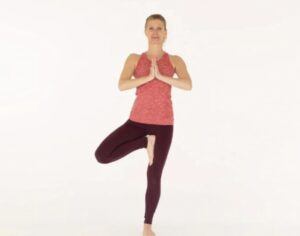
- Start in Mountain pose.
- Shift your weight onto your right leg. Bend your left knee and place your foot on your upper right thigh with your toes pointing down.
- Square your hips by lengthening your tailbone toward the ground and drawing your pelvis up toward your head. Imagine drawing a line between your two frontal hip points.
- Place your hands on your hips, bring your palms together at your heart centre or reach your arms overhead.
3. Cobra Pose
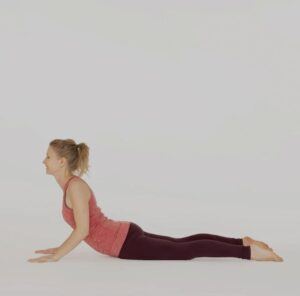
- Lie on your stomach with your legs together, the tops of your feet down and your hands under your shoulders.
- As you inhale, lift your chest away from the floor. Roll your shoulders back and down your spine as you straighten your arms as much as your flexibility allows.
- Breathe deeply and maintain awareness of the feedback your body is providing to avoid stress or strain.
- Lower your chest back down to the floor in the starting position.
4. Downward Dog Pose
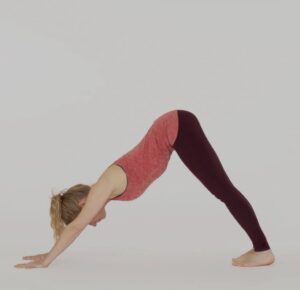
- Kneel on all fours on a yoga mat with your knees directly below your hips.
- Place your hands with your fingers spread slightly forward of your shoulders.
- Inhale and then exhale as you lift your knees from the mat. Keep them bent as you raise your buttocks upward.
- Slowly straighten your knees, keeping them soft. Make sure your head stays between your outstretched arms as you tighten them.
- Keep your shoulders wide. Stay in this position for at least one minute, working your way up to two or three minutes.
5.Triangle Pose
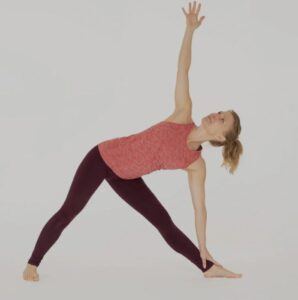
- Stand with your feet wide apart. Stretch your right foot out (90 degrees) while keeping the leg closer to the torso.
- Keep your feet pressed against the ground and balance your weight equally on both feet.
- Inhale and as you exhale Rest your right hand on your shin, ankle, or the floor outside your right foot, Stretch your left arm toward the ceiling.
- Turn your gaze up to the top hand and stay in this pose for 6-8 breaths. Inhale to come up and repeat on the opposite side.
Practising these 5 yoga poses on a regular basis will help learn the basics of yoga. Once you feel comfortable performing all of these exercises you can move on and try out some more advanced poses.
Top 5 Advanced Yoga Poses
Learning yoga requires a lot of dedication and hard work. All of the poses below are very advanced yoga poses and require a lot of upper body strength, flexibility and balance. Do not be disheartened if you can not perform them straight away as they will all require a lot of hard work and practise to master.
1.Extended Triangle Pose
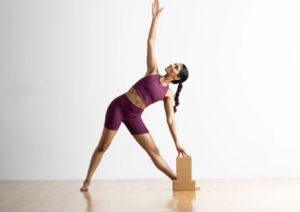
- Start in warrior II position with your right knee bent, straighten your right leg and hinge at your hip to connect your right hand to your right thigh, calf, or foot.
- Press into the ball of your front foot and bend your knee, feeling your thigh and calf muscles engage around the joint.
- Drive down through the outer edge of your left foot and engage the left side of your waist, as if you’re trying to side-bend toward the ceiling.
- Draw your left shoulder blade back toward your spine to help turn your chest toward your mat’s long edge. Take a few breaths here and then repeat on the other side.
2.Headstand
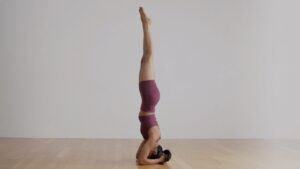
- Start in downward-facing dog.
- Drop your knees and forearms.
- Twist your fingers and push the front of your head into your twisted fingers.
- Tense your forearms, tuck your toes, and lift your hips.
- Once you have a stable and comfortable foundation, walk your feet closer to yourself.
- Bring one knee to your chest and then the other. Stay here and find balance. Once you’re ready, extend both legs into a headstand.
- Stare at something that’s not moving and activate your core and forearms.
3.Handstand
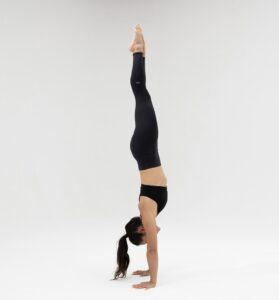
- Start in standing split position.
- Place your palms onto the mat directly below your shoulders and gaze at the space between your hands.
- Stack the standing foot directly below your hip with a slight bend in the knee.
- Engage your core and kick up with control, drawing the thigh up and into the hip socket to lead with the standing leg.
- Reach the lifted leg straight up and engage through your toes.
- Bring your legs together with your big toes touching and heels slightly separated.
4. Twisted Floor Bow Pose
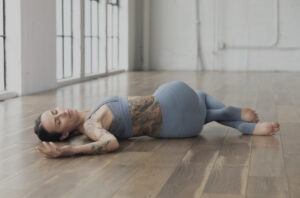
- Start in sphinx pose.
- Extend your right arm forward, move your left arm over to the opposite side and come down onto your elbow (Make sure that the elbow is lower than your shoulder),
- Curl your legs up and in as you reach your toes toward your back.
- Reach back with your right hand and grab hold of the left foot.
- Reach back with your left hand and grab hold of the right toes.
- Kick your left foot into your right hand as you lift your knee up to help lift your chest, head and shoulders off the ground.
5.Crow Pose
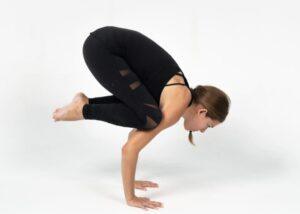
- Start in a standing forward fold.
- Bend your knees and plant your palms shoulder-width apart on your mat.
- Spread your weight evenly over all 10 knuckles, all 10 fingertips, and across both palms.
- Bend your elbows, then rise to your tiptoes and wrap your knees around your upper arms’ outsides.
- Move your thighs and elbows toward the midline as if you’re squeezing a beach ball between them.
- Lift your navel toward your spine and look forward past your fingertips.
- Lean forward until your head and shoulders start to balance the weight of your legs.
- When you feel light on your tiptoes, squeeze your heels toward your sit bones, and take flight.
Yoga is becoming more popular year after year for the many benefits it offers, both mentally and physically. Let’s take a look at some of the benefits yoga offers for your mental health.
Benefits of Yoga for Mental Health
Yoga is arguably one the best things you can possibly do to increase your mental health for many reason. Here are some of the reasons:
1. Reduces Stress: Yoga is well known to reduce stress levels as it’s purpose is to relax your mind and body. The combination of physical postures, controlled breathing, and meditation techniques helps to relax your body and mind, reducing cortisol levels and promoting a sense of calm.
2. Decreases Anxiety and Depression: Numerous studies have shown that regular yoga practice can massively reduce symptoms of anxiety and depression. It provides individuals with tools to manage negative thought patterns and emotions.
3. Improved Sleep Quality: Insomnia and poor sleep are issues that yoga can solve. Relaxation techniques and mindfulness practices help calm the mind and prepare the body for restful sleep.
3. Increases Emotional Well-Being: Yoga promotes self-acceptance, compassion, and gratitude. People have often report improved mood, greater emotional resilience, and a more positive outlook on life when regularly practising yoga.
5. Mindfulness and Presence: Yoga encourages mindfulness, teaching people to be fully present in the moment. This can improve concentration, decision-making, and overall mentality.
Now we have covered the benefits yoga has on your mental health, let’s take a look at some of the benefits yoga offers for your physical health.
The Benefits of Yoga for Physical Health
As well as being one of the best things you can do for your mental health, yoga also has many benefits for physical health. Here are some of the benefits:
1.Increases Flexibility and Range of Motion: Regular yoga practice increases flexibility and joint mobility. Improved flexibility can help prevent injuries and reduce muscle tension, during and after a workout.
2. Balance and Coordination: Yoga poses require a large amount of balance and coordination. Practicing these postures can improve stability and reduce the risk of falls, particularly in elderly people.
3. Strength and Muscle Definition: Yoga poses require engaging and stabilizing various muscle groups, leading to improved overall strength and muscle definition.
4. Pain Relief: Studies show that yoga can help to reduce chronic pain conditions, such as lower back pain, arthritis, and migraines. It helps individuals develop a greater awareness of their bodies and reduce tension.
Tips For Yoga Beginners
If you are new to yoga is it can sometimes be overwhelming. Here are some tips for people who are just starting their yoga journey, or for those trying to deepen their yoga skills.
1. Start Slowly: If you’re a beginner, begin with gentle yoga classes or by practising some of the beginner yoga poses above and then gradually progress to more advanced postures.
2. Find the Right Style: Explore different yoga styles to find one works for you. Hatha, Vinyasa, Iyengar, and Restorative are just a few of the many styles available.
3. Stay Consistent: Consistency is key to experiencing the full benefits of yoga. Aim to practice regularly, even if it’s just for a few minutes each day.
4. Seek Guidance: Consider taking classes with experienced instructors who can provide guidance on proper alignment and technique.
5. Listen to Your Body: It is important to pay attention to your body’s signals, and modify poses as needed to avoid strain or injury.
6. Create a Peaceful Space: Dedicate a quiet, uncluttered space and make it comfortable for your practice.
Following these tips will help you kickstart your yoga journey. If you use these tips whilst practising some of the yoga poses for beginners, you will soon build up the confidence to move onto the more advanced poses.
Conclusion: The Power of Yoga
Yoga is more than a physical practice, it’s a path to is a path to health and well-being. By embracing the mental and physical benefits of yoga, we can experience improved stress management, enhanced physical fitness, and a deeper connection to ourselves and the world around us.
It is an a commitment to self-care, and is amazing to improve both your mental and physical health. So, roll out your mat, try out some of the exercises covered today, and embark on your yoga journey.
I hope that you found this article interesting and have found a new love for yoga, if you didn’t already have one. Feel free to leave any questions or comments below, and share this article with others who might want to go on this new journey with you.
